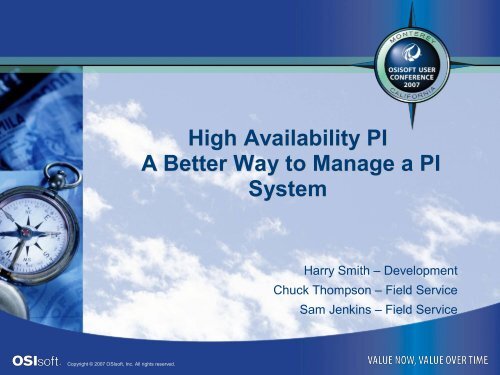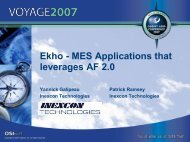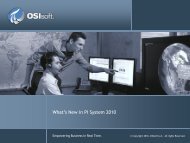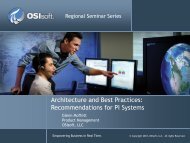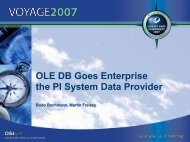High Availability PI A Better Way to Manage a PI System ... - OSIsoft
High Availability PI A Better Way to Manage a PI System ... - OSIsoft
High Availability PI A Better Way to Manage a PI System ... - OSIsoft
You also want an ePaper? Increase the reach of your titles
YUMPU automatically turns print PDFs into web optimized ePapers that Google loves.
Copyright © 2007 <strong>OSIsoft</strong>, Inc. All rights reserved.<br />
<strong>High</strong> <strong>Availability</strong> <strong>PI</strong><br />
A <strong>Better</strong> <strong>Way</strong> <strong>to</strong> <strong>Manage</strong> a <strong>PI</strong><br />
<strong>System</strong><br />
Harry Smith – Development<br />
Chuck Thompson – Field Service<br />
Sam Jenkins – Field Service
Massive <strong>High</strong>ly Available <strong>System</strong>s<br />
2
HA<strong>PI</strong> Purposeful Design<br />
3
HA<strong>PI</strong> is for …<br />
4
HA<strong>PI</strong> is for …<br />
5
HA<strong>PI</strong> is for …<br />
6
Upgrades are not always timely …<br />
7
But the results are worth it<br />
8
<strong>PI</strong> Replication Architecture<br />
Secondary<br />
Secondary<br />
<strong>PI</strong><br />
<strong>PI</strong><br />
Server<br />
Server<br />
<strong>PI</strong> Server Collective<br />
Data Buffering<br />
Services<br />
<strong>PI</strong> Interfaces<br />
<strong>System</strong><br />
<strong>Manage</strong>ment<br />
Tools<br />
Configuration<br />
Changes<br />
Failover Mechanism<br />
Thin Clients: RtPortal, RtWebParts,<br />
Rich Clients: ProcessBook, DataLink, Cus<strong>to</strong>m<br />
Application…<br />
<strong>PI</strong>SDK<br />
Primary<br />
Primary<br />
<strong>PI</strong><br />
<strong>PI</strong><br />
Server<br />
Server<br />
Identical<br />
TimeSeries<br />
Data Buffering<br />
Services<br />
<strong>PI</strong> Interfaces<br />
Secondary<br />
<strong>PI</strong> Server(s)<br />
9
<strong>PI</strong> Replication Summary<br />
Features<br />
– Synchronization of <strong>PI</strong> Server configuration<br />
– Transparent client failover, simple load balancing<br />
– Fanning of realtime data <strong>to</strong> multiple servers<br />
Value<br />
– <strong>High</strong> <strong>Availability</strong> <strong>to</strong> your <strong>PI</strong> <strong>System</strong><br />
– Peace of mind for Administra<strong>to</strong>rs<br />
– Direct support for existing <strong>PI</strong> Clients<br />
– Simple, scalable and flexible<br />
architecture<br />
10
<strong>PI</strong>HA Components<br />
<strong>PI</strong> Server<br />
– Replication specific features:<br />
• Configuration change logging & replication services<br />
• Moni<strong>to</strong>ring services & troubleshooting <strong>to</strong>ols<br />
– Performance, reliability features<br />
SDK<br />
– Au<strong>to</strong>matic failover mechanisms for existing SDK clients<br />
– Advanced HA services OSI clients<br />
Bufserv<br />
– Fanning of data <strong>to</strong> multiple servers<br />
Bufss<br />
– Guarantees identical archive data between replicated servers<br />
– Increased buffering capacity, efficiency & throughput<br />
SMT<br />
– Collective <strong>Manage</strong>r HA moni<strong>to</strong>ring & administration<br />
11
Limitations<br />
No au<strong>to</strong>matic replication of non interface data<br />
No replication of batch records<br />
Post processed data calculated independently<br />
<strong>PI</strong> ACE management requires primary<br />
12
<strong>PI</strong> Replication Future<br />
Enterprise Data Center<br />
<strong>PI</strong> Server<br />
<strong>PI</strong> Server<br />
Node<br />
Node<br />
Regional Center 1<br />
Aggregated<br />
Aggregated<br />
<strong>PI</strong> Server<br />
<strong>PI</strong> Server<br />
Primary<br />
<strong>PI</strong><br />
Primary<br />
Server<br />
<strong>PI</strong> Server<br />
Archive<br />
Mirroring<br />
<strong>PI</strong> Server<br />
<strong>PI</strong> Server<br />
Node<br />
Node<br />
Aggregated, Federated <strong>PI</strong> Server<br />
Aggregated, Federated <strong>PI</strong> Server<br />
Site A<br />
Primary<br />
<strong>PI</strong><br />
Primary<br />
Server<br />
<strong>PI</strong> Server<br />
Data Mining, Business Intelligence Services<br />
<strong>PI</strong> Server<br />
<strong>PI</strong> Server<br />
Node<br />
Node<br />
<strong>PI</strong> <strong>PI</strong> Interfaces Interfaces<br />
<strong>PI</strong> Server<br />
<strong>PI</strong> Server<br />
Node<br />
Node<br />
Secondary<br />
<strong>PI</strong><br />
Secondary<br />
Server<br />
<strong>PI</strong> Server<br />
…<br />
Regional Center 2<br />
Aggregated<br />
Aggregated<br />
<strong>PI</strong> Server<br />
<strong>PI</strong> Server<br />
Site B<br />
Primary<br />
<strong>PI</strong><br />
Primary<br />
Server<br />
<strong>PI</strong> Server<br />
<strong>PI</strong> Clients<br />
<strong>PI</strong> <strong>PI</strong> Interfaces Interfaces<br />
Client Access Layer<br />
<strong>PI</strong> Caching Server<br />
Secondary<br />
<strong>PI</strong><br />
Secondary<br />
Server<br />
<strong>PI</strong> Server<br />
13
Straight talk from the Pros<br />
14
Copyright © 2007 <strong>OSIsoft</strong>, Inc. All rights reserved.<br />
How <strong>High</strong> <strong>Availability</strong> <strong>PI</strong><br />
can work in a test Environ<br />
Chuck Thompson – Field Service
HA – It’s Simple<br />
….but neither is<br />
HA so complicated<br />
as all this.<br />
HA is not quite this<br />
simple….<br />
16
How HA & PR1 can work in a test<br />
environ<br />
In the test – you continue <strong>to</strong> use the existing <strong>PI</strong>3<br />
server<br />
17
Preparing for the test<br />
You’ll need <br />
One or more test servers<br />
– Standard hardware and operating system is all that’s required<br />
Upgrade underlying <strong>PI</strong>A<strong>PI</strong> & <strong>PI</strong>SDK on your<br />
interface nodes<br />
– If you can use a secondary or test interface node, you may<br />
want <strong>to</strong> consider this<br />
Consider upgrading your interface <strong>to</strong> the latest<br />
version<br />
Use SMT or ICU on the interface node <strong>to</strong> setup and<br />
moni<strong>to</strong>r the test<br />
18
Setting up for the test<br />
Start your upgrades at the <strong>PI</strong> server<br />
– Prepare the new server (O/S, network, etc)<br />
– Use documented procedure for moving <strong>PI</strong> <strong>to</strong> a new<br />
server)<br />
– Upgrade <strong>PI</strong> clone <strong>to</strong> latest version<br />
– Update <strong>PI</strong> management <strong>to</strong>ols <strong>to</strong> latest version and apply<br />
patches, if any<br />
– Use <strong>PI</strong> collective manager <strong>to</strong> promote your <strong>PI</strong> clone in<strong>to</strong><br />
a collective with one member<br />
– Optionally add in additional test <strong>PI</strong> servers <strong>to</strong> your<br />
collective<br />
19
Continue with interface nodes<br />
If the interfaces aren’t already on interface nodes,<br />
move them off of the <strong>PI</strong> server<br />
Upgrade <strong>PI</strong>A<strong>PI</strong> & <strong>PI</strong>SDK<br />
– Easy way <strong>to</strong> do this is <strong>to</strong> install latest SMT or ICU<br />
Optionally upgrade your interface(s) <strong>to</strong> latest<br />
version<br />
Set up N<strong>Way</strong> buffering using latest <strong>PI</strong>A<strong>PI</strong><br />
Buffering version<br />
– <strong>PI</strong>ICU makes it easy <strong>to</strong> implement buffering and <strong>to</strong> set your<br />
interface(s) dependencies<br />
20
The Test<br />
What’s running?<br />
– At the test <strong>PI</strong>3 server(s) you have PR1 version of <strong>PI</strong><br />
– The interface nodes should be buffering data <strong>to</strong> both old and<br />
new <strong>PI</strong>3 servers<br />
– The snapshot and archive data of existing <strong>PI</strong>3 server and<br />
test <strong>PI</strong>3 server should be identical<br />
Copy some of your existing applications<br />
(ProcessBook files, DataLink spreadsheets) and<br />
use PR1 client versions <strong>to</strong> test against data from<br />
test <strong>PI</strong>3 server<br />
21
The Test<br />
22
Next Steps<br />
Test client applications against the test server<br />
– Allow key users <strong>to</strong> switch <strong>to</strong> the test server<br />
– If you have more than one server in your collective, test failover<br />
Test your local procedures, e.g. backup, O/S<br />
patches, and other system management or<br />
maintenance tasks<br />
With OSI’s Tech Support, Training, and Field<br />
Service – resolve any issues or problems you<br />
encounter<br />
23
Test as long as you like<br />
Both systems operational<br />
– If you don’t like the test, abandon the test<br />
• Just shutdown and uninstall the test <strong>PI</strong> server(s)<br />
• Remove additional server(s) from buffering<br />
configuration on each interface node<br />
Configuration changes made <strong>to</strong> existing<br />
system during the test are not reflected in<br />
the test system during the period of parallel<br />
operation<br />
24
A time line<br />
25
Test successful! What next?<br />
Uninstall <strong>PI</strong> from test server(s)<br />
Make a new clone from the existing <strong>PI</strong> server (e.g.<br />
move <strong>PI</strong> <strong>to</strong> new server)<br />
Make your <strong>PI</strong> collective<br />
Point users at new collective<br />
– Upgrade <strong>to</strong> PR1 versions<br />
Remove old <strong>PI</strong> server from buffering on interface<br />
nodes<br />
26
Benefits<br />
Test on a clone of your <strong>PI</strong> system without disrupting your<br />
user community or data<br />
Version <strong>Manage</strong>ment<br />
– It becomes easier <strong>to</strong> stay current – apply changes <strong>to</strong> secondary node and<br />
test<br />
– Updates can be applied <strong>to</strong> a single collective member without having <strong>to</strong><br />
take an outage of entire <strong>PI</strong> system<br />
– This opportunity applies not only <strong>to</strong> OSI software releases but<br />
more especially <strong>to</strong> updates from Microsoft, your AntiVirus vendor,<br />
backup system, etc.<br />
Test applications on parallel test system before “going live”<br />
Test system management features and local procedures<br />
against test system using live data<br />
27
Summary –<br />
It’s time<br />
You have a 2 or 3 year old version of <strong>PI</strong> on Windows<br />
and you have been putting off upgrades, patches, etc<br />
If you have <strong>PI</strong>3 server on UNIX, this would be a<br />
good time <strong>to</strong> switch <strong>to</strong> <strong>PI</strong>3 server on Windows<br />
HA and PR1 are there, OSI built them for all <strong>to</strong> use<br />
HA is already at work for dozens of cus<strong>to</strong>mer’s<br />
critical systems<br />
28
Useful Resources<br />
OSI’s <strong>PI</strong>3 <strong>System</strong> <strong>Manage</strong>r II class,<br />
Advanced Skills<br />
– Large portion of the class gives practical hands on with<br />
redundant interface and HA <strong>PI</strong> server<br />
OSI has field service <strong>to</strong> provide onsite<br />
assistance and help in planning.<br />
Contact your OSI sales person for questions<br />
on licensing & quotes for field service<br />
29
<strong>High</strong> <strong>Availability</strong> <strong>PI</strong><br />
Experiences From the Trenches<br />
Copyright © 2007 <strong>OSIsoft</strong>, Inc. All rights reserved.<br />
Sam Jenkins – Field Service
<strong>High</strong> <strong>Availability</strong> Solves Problems<br />
31
<strong>High</strong> <strong>Availability</strong> Solves Problems<br />
32
<strong>High</strong> <strong>Availability</strong> Case Studies<br />
Case Study A<br />
– Traditional <strong>High</strong> <strong>Availability</strong> Scenario<br />
– Rapid Deployment<br />
– <strong>Manage</strong>d <strong>PI</strong> Environment<br />
Case Study B<br />
– <strong>High</strong> <strong>Availability</strong> Solves a Unique Problem<br />
33
Case Study A<br />
Secondary<br />
Secondary<br />
<strong>PI</strong><br />
<strong>PI</strong><br />
Server<br />
Server<br />
<strong>PI</strong> Server Collective<br />
<strong>System</strong><br />
<strong>Manage</strong>ment<br />
Tools<br />
Configuration<br />
Changes<br />
RtPortal, RtWebParts,<br />
ProcessBook, DataLink,<br />
<strong>PI</strong>SDK<br />
Primary<br />
Primary<br />
<strong>PI</strong><br />
<strong>PI</strong><br />
Server<br />
Server<br />
Identical<br />
TimeSeries<br />
<strong>PI</strong> Buffer<br />
Subsystem<br />
ModBusE Interface<br />
<strong>PI</strong> Buffer<br />
Subsystem<br />
<strong>PI</strong> ACE<br />
34
Case Study A<br />
<strong>Manage</strong>d <strong>PI</strong> Environment<br />
– A<strong>PI</strong> N<strong>Way</strong> Buffering used <strong>to</strong> send local<br />
Performance Moni<strong>to</strong>r data between servers<br />
in the collective<br />
<strong>PI</strong> Server Collective<br />
Secondary<br />
Secondary<br />
<strong>PI</strong><br />
<strong>PI</strong><br />
Server<br />
Server<br />
A<strong>PI</strong> n<strong>Way</strong> Buffering<br />
Perfmon Data<br />
Primary<br />
Primary<br />
<strong>PI</strong><br />
<strong>PI</strong><br />
Server<br />
Server<br />
35
Case Study A<br />
Rapid Deployment<br />
– <strong>High</strong> <strong>Availability</strong> Architecture Implemented at 8 sites in 5 Weeks<br />
– Collective <strong>Manage</strong>r Simplifies Collective Creation<br />
36
Case Study B<br />
<strong>PI</strong><br />
<strong>PI</strong><br />
Server<br />
Server<br />
Troublesome WAN Connection<br />
Plant 1 Plant 2<br />
37
Case Study B<br />
Initial Problems<br />
– Users at Plant 2 cannot reliably access <strong>PI</strong><br />
system<br />
– Plant 2 data archival constantly delayed<br />
38
Case Study B: Solution 1<br />
<strong>PI</strong><br />
<strong>PI</strong><br />
Server<br />
Server<br />
Troublesome WAN Connection<br />
<strong>PI</strong><br />
<strong>PI</strong><br />
Server<br />
Server<br />
Plant 1 Plant 2<br />
39
Case Study B: Solution 1<br />
Solution 1 Problems<br />
– All client applications needing data for Plant<br />
2 must be redirected <strong>to</strong> new server<br />
– Additional task of splitting existing <strong>PI</strong> server<br />
required<br />
40
Case Study B: <strong>Better</strong> Solution<br />
<strong>PI</strong><br />
<strong>PI</strong><br />
Server<br />
Server<br />
<strong>PI</strong> Server Collective<br />
Plant 1 Plant 2<br />
Troublesome WAN Connection<br />
<strong>PI</strong><br />
<strong>PI</strong><br />
Server<br />
Server<br />
41
Case Study B: <strong>Better</strong> Solution<br />
Implement <strong>High</strong> <strong>Availability</strong><br />
– One member of the collective resides at<br />
each plant<br />
– Collective named <strong>to</strong> match that of the<br />
existing <strong>PI</strong> server so existing client<br />
applications don’t need reconfiguration<br />
– Users connections at each plant set <strong>to</strong> prefer<br />
their local <strong>PI</strong> server collection member<br />
42
Case Study B: Result<br />
Each server continues <strong>to</strong> archive and buffer<br />
data locally during network disruptions and<br />
forwards the data <strong>to</strong> other collective members<br />
as they become available<br />
Avoided cost of splitting existing <strong>PI</strong> server and<br />
reconfiguring client nodes<br />
<strong>PI</strong> data is highly available<br />
43
Conclusions<br />
There are many uses for <strong>High</strong> <strong>Availability</strong><br />
– Traditional HA<br />
– Managing version upgrades<br />
– Solving unique implementation challenges<br />
44
Copyright © 2007 <strong>OSIsoft</strong>, Inc. All rights reserved.


